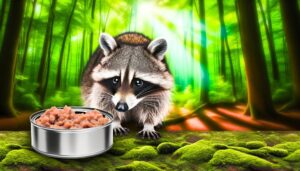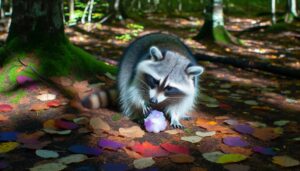How Do Raccoons Live in England?
Raccoons are not native to England, and there is no established breeding population in the country. Occasional sightings are primarily due to escaped or released pets.
Legally, it is prohibited to release raccoons into the wild under the Wildlife and Countryside Act 1981 and the Invasive Alien Species Order 2019. These animals can compete with native species, potentially spreading diseases and causing ecological harm.
Management efforts aim to prevent their establishment. For an in-depth understanding of raccoons' impact and measures taken to manage these sightings, continue learning about their ecological roles and presence in non-native environments.

Key Takeaways
- Raccoons in England are primarily due to escaped or released pets.
- There is no evidence of established breeding populations of raccoons in England.
- Sightings of raccoons are sporadic and mainly in suburban areas.
- Releasing raccoons into the wild is prohibited by the Wildlife and Countryside Act 1981.
- Raccoons are listed as a species of concern under the Invasive Alien Species Order 2019.
Raccoons' Natural Habitat
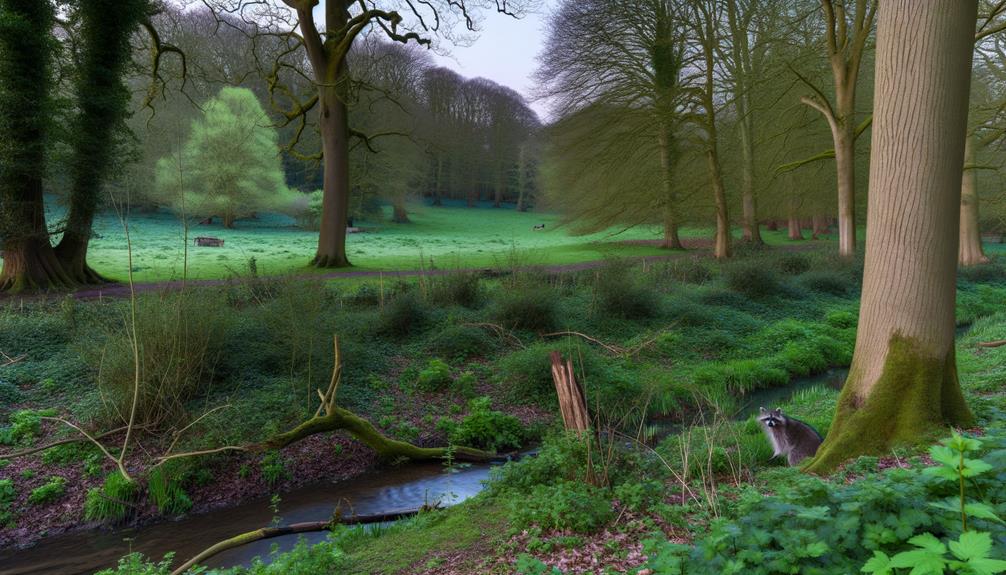
Raccoons' natural habitat primarily consists of deciduous and mixed forests, although they have demonstrated remarkable adaptability to various environments including urban areas. These mammals are typically found in regions abundant with water sources, such as rivers, streams, and wetlands, which provide both hydration and food.
Their diet is omnivorous, including fruits, nuts, insects, small vertebrates, and even human refuse. The adaptability of raccoons is further evidenced by their ability to thrive in suburban and metropolitan settings, where they exploit available resources. The species' nocturnal habits and dexterous front paws facilitate foraging and interaction with diverse habitats.
Understanding their ecological preferences is critical for comprehending their distribution, behavior, and potential impact on various ecosystems.
Raccoon Sightings in England
Instances of raccoon sightings in England have been sporadic and largely attributed to escaped or released pets rather than established wild populations. Documented cases indicate that these sightings are typically isolated events with no evidence of breeding populations or territorial establishment.
Reports are often concentrated in suburban areas where raccoons might find refuge and food sources, such as gardens and waste bins. These occurrences are carefully monitored by wildlife authorities to prevent potential ecological impacts. Genetic studies on captured raccoons reveal no significant genetic diversification, supporting the theory of recent and isolated introductions.
While raccoons are adaptable, the lack of consistent sightings suggests that England's environment does not currently support a sustainable, self-replicating raccoon population.
Legal Status of Raccoons
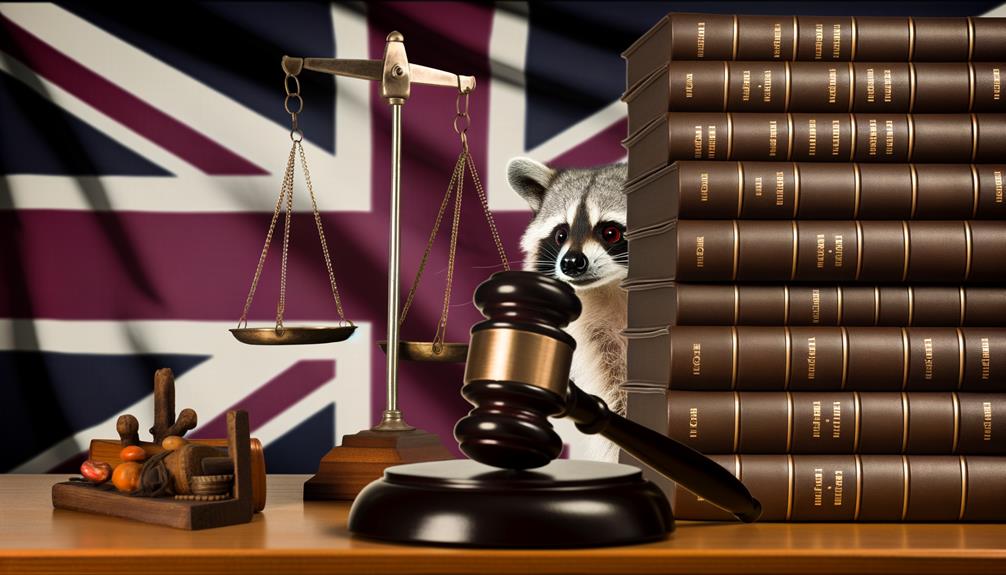
The legal status of raccoons in England is primarily governed by wildlife protection laws and regulations concerning non-native species. Raccoons, which are not native to England, fall under several legislative frameworks designed to control their presence and prevent potential ecological disruptions.
- Wildlife and Countryside Act 1981: This act prohibits the release of non-native species into the wild, including raccoons, to protect native ecosystems.
- Invasive Alien Species (Enforcement and Permitting) Order 2019: This order enforces strict control and management of invasive species, listing raccoons as a species of concern.
- Animal Welfare Act 2006: Governs the humane treatment of raccoons in captivity.
- Convention on Biological Diversity (CBD): International agreement that influences national policies concerning invasive species management.
These regulations collectively aim to mitigate the risks associated with raccoons in England.
Ecological Impact
Introduction of raccoons into England's ecosystems can lead to significant disturbances in native biodiversity and ecological balance. Raccoons are opportunistic feeders and can exploit a wide range of food sources, potentially outcompeting native species. Their foraging behavior can disrupt local flora and fauna, leading to habitat degradation. Additionally, raccoons may act as vectors for various diseases, further threatening native wildlife. The following table outlines some potential ecological impacts:
| Ecological Factor | Impact of Raccoons | Consequences for Native Ecosystems |
|---|---|---|
| Competition for Food | Outcompeting native species | Reduced food availability |
| Disease Transmission | Vectors for parasites and pathogens | Increased disease prevalence |
| Habitat Modification | Destruction of nests and vegetation | Loss of habitat quality |
This multifaceted impact underscores the importance of careful ecological management.
Comparison With Native Species
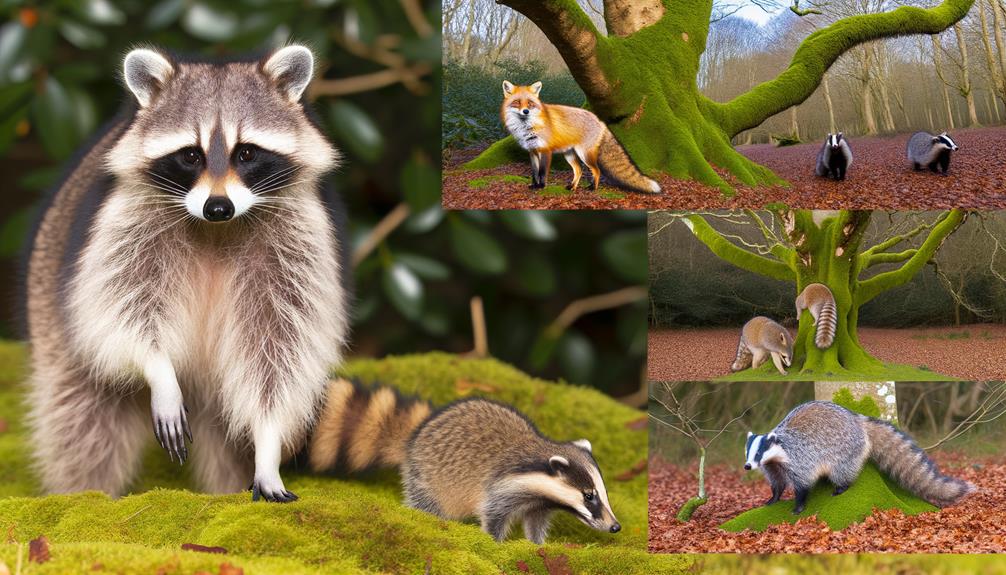
In comparing raccoons with native species, it is essential to examine their respective ecological roles, feeding behaviors, and adaptability to local environments. Raccoons, being omnivorous and highly adaptable, differ noticeably from many native British species.
Notably, when compared to native fauna such as the European hedgehog and red fox, several distinctions arise:
- Ecological Roles: Raccoons serve as both predator and scavenger, unlike hedgehogs primarily consuming invertebrates.
- Feeding Behaviors: Raccoons exhibit diverse diets, contrasting with the more specialized diets of many native species.
- Adaptability: Raccoons thrive in urban settings, while some natives, like the badger, prefer rural habitats.
- Nocturnal Activity: Both raccoons and native species like foxes are nocturnal, yet their foraging strategies differ noticeably.
These comparisons highlight noticeable ecological variances.
Potential Risks and Benefits
The introduction of raccoons to England presents a complex scenario involving potential risks and benefits. Key concerns include the transmission of diseases to native wildlife and humans, the impact on local biodiversity, and possible disruptions to the ecological balance.
Conversely, their presence could offer unique opportunities for ecological studies and foster increased public interest in wildlife conservation.
Disease Transmission Concerns
Given the invasive nature of raccoons, their potential introduction to England raises significant concerns regarding the transmission of zoonotic diseases to both humans and native wildlife. Raccoons are known carriers of several pathogens that could pose serious health risks.
- Rabies: Raccoons are significant rabies vectors, potentially introducing this fatal viral disease to new regions.
- Baylisascaris procyonis: This raccoon roundworm can cause severe neurological damage in humans and other animals if ingested.
- Leptospirosis: A bacterial disease that can affect the kidneys and liver, transmissible to humans through raccoon urine.
- Raccoon Parvovirus: This can severely affect local wildlife, particularly species with no prior exposure or immunity.
Addressing these risks requires thorough wildlife management and public health strategies.
Biodiversity Impact Analysis
Frequently, the introduction of non-native species such as raccoons can disrupt local ecosystems to a large extent, leading to both detrimental and beneficial impacts on biodiversity. Raccoons, being opportunistic omnivores, can alter food web dynamics by preying on native species and competing for resources. This can lead to declines in native populations and biodiversity loss. Conversely, raccoons may also contribute positively by controlling pest populations and contributing to seed dispersal.
| Potential Risks | Potential Benefits |
|---|---|
| Predation on native species | Pest population control |
| Competition for resources | Seed dispersal |
| Spread of invasive plant species | Increased ecosystem resilience |
Ecological Balance Disruption
Introduction of raccoons into non-native environments can disrupt ecological balance, posing both potential risks and benefits to local ecosystems. Scientifically, such introductions can lead to significant changes in biodiversity and ecosystem functioning. Key considerations include:
- Predation: Raccoons may prey on native species, leading to declines in local fauna.
- Competition: They could outcompete native species for resources like food and habitat.
- Disease Transmission: Raccoons carry diseases such as rabies and leptospirosis, which can spread to native wildlife and humans.
- Ecosystem Services: Conversely, raccoons might fulfill ecological roles such as seed dispersal, potentially benefiting plant diversity.
Understanding these dynamics is important for evaluating the overall impact of raccoon introduction on England's ecosystems.
Conclusion
To summarize, while raccoons are not native to England, there have been occasional sightings.
The legal status of raccoons in England reflects concerns over their potential ecological impact, which includes competition with native species and the spread of diseases.
Comparatively, like an errant knight in a foreign land, raccoons pose risks that must be carefully managed to protect local biodiversity.
This analysis underscores the importance of monitoring and regulation to mitigate any adverse effects on the ecosystem.




